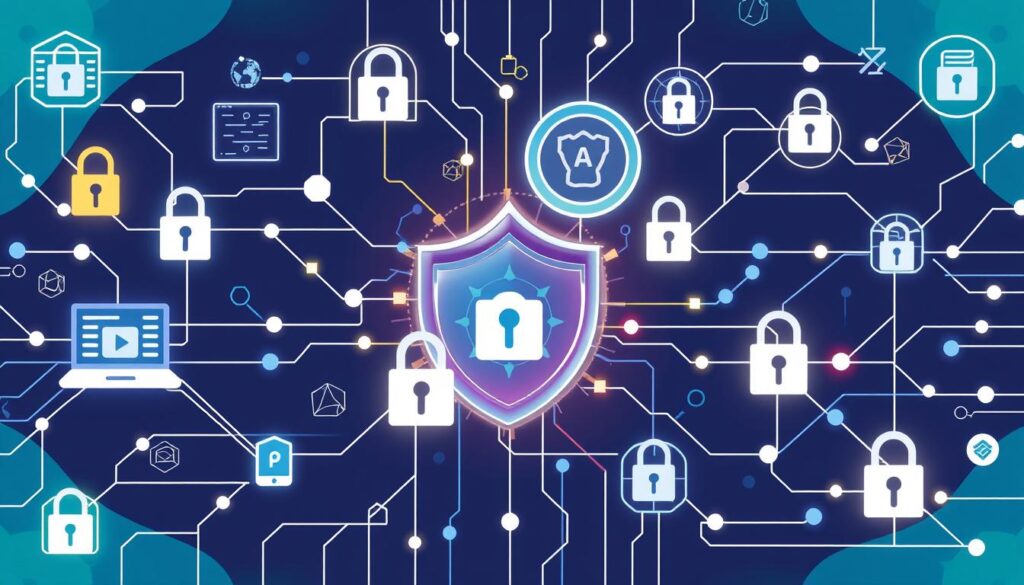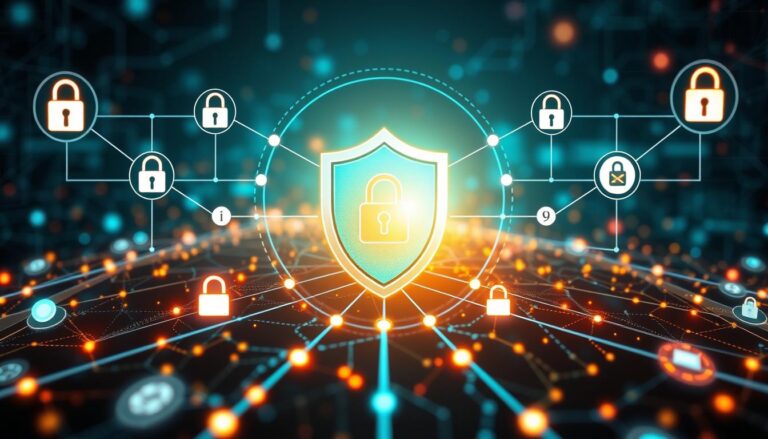
Did you know that strong cybersecurity risk management can cut down on cyber attacks? Today, combining IT security governance is key to protecting data and following rules like GDPR and PCI DSS. A good IT security governance plan doesn’t just handle risks. It also builds a culture of cybersecurity in your company.
For businesses going through digital change, knowing about governance frameworks is vital. These frameworks set up roles, check for compliance, and help improve through audits. As companies move to the cloud, having a governance that keeps up with threats is more important than ever.
Understanding IT Security Governance
In today’s digital world, companies face many cybersecurity challenges. IT security governance is key to managing these issues. It includes policies, practices, and roles needed to handle cybersecurity risks. With good governance, you can protect your organization better against threats.
What is IT Security Governance?
IT security governance is a strategic plan to make sure cybersecurity fits with your business goals. It sets up information security policies that show how to protect your data. This framework also encourages a security-aware culture in your company. So, companies with strong IT security governance can better handle risks and incidents.
The Importance of IT Security Governance
IT security governance is very important. Studies show that 70% of companies struggle to match their security governance with business goals. This mismatch can make decision-making and risk management harder. By creating detailed information security policies, you can make compliance easier and protect sensitive data. This builds trust with your stakeholders.
Also, companies that focus on cybersecurity governance can manage risks better. For example, 80% of those using the NIST Cybersecurity Framework see better risk management. With these frameworks, you can find and fix vulnerabilities before they cause problems.
Good IT security governance helps you be proactive instead of just reacting to problems. Research shows that companies with strong governance are 50% less likely to have data breaches. Investing in strong governance makes your organization more secure.
| Statistic | Percentage |
|---|---|
| Organizations struggling with governance alignment | 70% |
| Companies with a formalized governance framework | 50% less likely to face breaches |
| Organizations reporting improved stakeholder trust | 89% |
| Executives understanding cybersecurity governance importance | 83% |
| Companies lacking a formal information security governance framework | 1 in 5 |
In summary, having a solid IT security governance framework is vital in today’s complex cybersecurity world. It helps with compliance, reduces risks, and builds a security-aware culture. This benefits your organization greatly.
Key Components of Effective IT Governance
Creating a solid IT governance framework means knowing and using several important parts. These parts help with strong cybersecurity and make sure leaders are responsible. This is key for handling risks and making sure IT goals match business plans.
Policies and Procedures
Policies and procedures are the base for managing IT governance. They guide everyone on what to do and how to do it. These rules should cover how to keep data safe and follow laws like HIPAA and GDPR.
Management Accountability
Having leaders who take responsibility is vital for good information security. ISO 27014 says top leaders must play a big role in setting up security systems. They need to push for security awareness and follow policies themselves. This makes security a part of the company’s culture.
Resource Allocation
It’s important to use resources well for a good IT governance setup. Companies should focus on the biggest security risks first. This means using money, technology, and people wisely to protect against threats. Regular checks help make sure resources are used right, keeping up with changing security needs.
| IT Governance Components | Description |
|---|---|
| Policies and Procedures | Framework for security practices that ensures compliance and risk management. |
| Management Accountability | Integration of leadership involvement in security initiatives and responsibilities. |
| Resource Allocation | Strategic distribution of budget, personnel, and technology to manage security risks effectively. |
By focusing on these key parts, companies can improve their IT governance. This leads to better risk management and resource use, all while following the law.
Frameworks Supporting IT Security Governance Integration
Organizations aiming to improve their IT security governance should look into frameworks like the NIST Cybersecurity Framework and ISO/IEC 27001. These frameworks provide structured methods for integrating security into business strategies. This enhances compliance and risk management.
NIST Cybersecurity Framework
The NIST Cybersecurity Framework (CSF) offers a risk-based approach to enhance security across various sectors. It was developed in 2013 under Executive Order 13636. It focuses on five key functions:
- Identify: Recognizing and managing cybersecurity risks.
- Protect: Implementing safeguards to ensure essential services.
- Detect: Monitoring for anomalies and events.
- Respond: Taking action regarding a detected cybersecurity incident.
- Recover: Restoring capabilities after an incident.
NIST SP 800-53 is a benchmark for information security, widely used by U.S. government agencies and the private sector. Following NIST standards can cut cybersecurity risks by up to 50%. This makes it a key consideration for organizations.
ISO/IEC 27001 Standards
ISO/IEC 27001 sets requirements for an Information Security Management System (ISMS). It covers over 60 standards addressing various information security challenges. To comply with ISO 27000 series standards, organizations undergo third-party audits and certification.
Implementing ISO/IEC 27001 can greatly improve an organization’s security posture. It reduces the chance of unauthorized access. The framework stresses accountability and continuous improvement, aligning with business goals.
By adopting frameworks like the NIST Cybersecurity Framework and ISO/IEC 27001, organizations can build a cohesive and efficient security governance landscape. This addresses both immediate and long-term cybersecurity threats.
| Framework | Focus Areas | Benefits |
|---|---|---|
| NIST CSF | Risk Management, Incident Response | Reduces risks, Enhances Cybersecurity |
| ISO/IEC 27001 | Information Security Management | Regulatory Compliance, Continuous Improvement |
Developing a Risk Management Framework
Creating a solid risk management framework is key to protecting your organization’s assets. It starts with spotting risks that could harm your data and operations. Knowing these threats lets you take steps to lessen their impact.
Identifying Risks
Identifying risks means looking closely at both inside and outside factors. Threats include cyber attacks and breaking rules. It’s important to check regularly to update your strategies.
With cybercrime costs expected to reach $10.5 trillion by 2025, being proactive is vital. By identifying risks, you protect your assets and show you follow the rules. This helps avoid big fines.
Assessing Vulnerabilities
After finding risks, you need to check for weaknesses. This step looks at areas where bad actors could strike. Using standards like NIST SP 800-39 or ISO/IEC 27005 helps you tackle these issues.
Working together across teams makes this process stronger. By customizing these frameworks for your business, you boost your security.
Implementing IT Security Controls
Setting up strong IT security controls is key to protecting your company’s sensitive data. It also helps meet legal standards. You need to focus on access control, data protection, and being ready for incidents.
Access Control Mechanisms
Access control is essential for controlling who can see or use your company’s resources. By using strict access controls, you lower the chance of unauthorized data access. Tools like role-based access control (RBAC) and multifactor authentication (MFA) boost your security.
Only letting the right people see sensitive data keeps your company safe from data breaches.
Data Protection Strategies
Companies must have strong plans to protect data at rest and in transit. Using encryption and data loss prevention (DLP) systems helps a lot. DLP can cut data breach success by 50%.
Having clear data handling and storage policies also strengthens your security.
Incident Response Plans
A good incident response plan helps your company handle security issues fast and well. This way, you can limit damage and follow the law better. Companies with a common security language see their response times drop by 25%.
Make sure to test and update your plan often. This keeps your team ready for any threat.
Training and Awareness Programs
Training and awareness programs are key to a strong security culture in organizations. They teach you about threats like phishing and social engineering, which lead to data breaches. With 95% of breaches caused by human error, it’s clear that training is essential.
Security Awareness Training
Good security awareness training teaches you to spot and handle cyber threats. Studies show that regular training helps detect cyberattacks better. It’s recommended to train monthly or more often, as people forget 80% of what they learn in just four weeks.
Continuous Learning Initiatives
Continuous learning keeps you updated on new cybersecurity threats and best practices. It’s important to update training to match new threats. Microlearning, which gives info in short, easy-to-remember chunks, helps keep you engaged.
Only 7% of companies train annually. Regular updates and flexible schedules can boost participation and effectiveness.

| Training Approach | Frequency | Effectiveness |
|---|---|---|
| Monthly Training | 51% of organizations | Higher retention and engagement |
| Annual Training | 7% of organizations | Lower engagement rates |
| Interactive Programs | Varies | Improved information retention |
| Microlearning | 1-4 times a month | Increased retention rates |
In conclusion, combining effective security training and continuous learning makes employees informed and proactive. This boosts your organization’s security governance.
Monitoring and Evaluating Security Effectiveness
Keeping your security strong needs constant work. You must check your security often to see what’s working and what’s not. This helps find areas to improve and keeps your strategies up to date with new threats.
Regular Audits and Assessments
Security audits are key, as 63% of security leaders do not report to the board about risks. This gap makes it hard to act fast when threats arise. Regular checks help see how well you’re doing and make sure your plans fit your needs.
Also, not having clear rules can lead to problems. This includes issues with who makes decisions and who is in charge.
Utilizing Threat Detection Technologies
Using the latest threat detection tools is important. Tools like AI and machine learning help spot threats fast. They help catch unauthorized access and odd activities right away.
Adding these tools to your security makes it stronger. It helps deal with the fear that old ways might not stop new threats.
IT Security Governance Integration
Integrating IT security governance brings big benefits. It helps organizations protect sensitive data better and follow new rules. It also makes sure resources are used well.
Working together across departments helps everyone focus on the same security goals. This makes it easier to fight off cyber threats.
Benefits of Integrated Governance
There are many good things about integrated governance. Here are a few:
- Streamlined risk management: A clear view of risks helps spot and fix problems early, stopping big threats before they start.
- Enhanced compliance readiness: Using frameworks like COBIT and ISO/IEC 27001 makes it easier to follow rules. This saves time and effort.
- Improved incident response: When security teams and business leaders work together, problems get fixed faster. This makes the security stronger and cuts down response times by up to 30%.
- Resource optimization: Planning security budgets wisely means spending on what’s most important. This helps manage risks better and makes things more efficient.
Common Challenges in Integration
Even with the benefits, there are hurdles to overcome. Some common ones are:
- Management resistance: Some leaders might be worried about more rules or changes in their roles.
- Inefficient communication: If departments don’t talk well, they might not work together on security plans.
- Resource constraints: Not having enough money or people for security makes it hard to set up a good system.
- Complexity and volume of tools: Having too many tools without a plan can make things confusing and harder to manage.

Conclusion
Getting IT security governance right is key to boosting your cybersecurity and making your organization strong. By following the best practices, like setting clear roles and following rules, you can handle risks better. This helps protect your data and keeps your business safe from big legal and financial problems.
Having a single, strong data security plan makes managing security easier. It helps avoid mistakes and fills in any gaps. Training everyone to be security-aware makes your whole team work together to keep your data safe.
Good IT security governance builds trust and keeps you in line with the law. It also makes your work flow smoother. As cyber threats get more common, having a solid, automated security plan is essential. It helps you deal with problems fast and keeps your business safe for the long run.
Source Links
- What is Cyber Security Governance & How to Achieve it?
- Securely Govern Your Cloud Estate – Cloud Adoption Framework
- Security Governance: Understanding, implementation, and best practices
- What Is Information Security Governance in Cybersecurity?
- Information Security Governance Framework Guide for IT Activities
- IT Governance Framework: Overview & Best Practices | ConnectWise
- Top 12 IT security frameworks and standards explained | TechTarget
- 15 IT Governance Frameworks for Effective IT Governance
- Overview: What is a Security Governance Framework | Gutsy
- How Security Governance Can Help Protect You from Cyberthreats
- Building an Information Security Risk Management (ISRM) Program, Complete Guide – Isora GRC
- Cybersecurity Governance | CISA
- A Guide to Information Security Governance
- How to Implement an Information Security Program in 9 Steps – BARR Advisory
- Employee Security Awareness Training: Why It’s Important
- Security Awareness Program Challenges | Arctic Wolf
- Establish Effective Security Governance & Manage…
- 5 Steps for Effective Data Security Governance
- How to Measure Security From a Governance Perspective
- 4 Common IT Security Integration Pitfalls and How to Avoid Them
- A Guide to CISM Domain 1: Information Security Governance
- Information Security Governance Roles and Responsibilities
- Strengthening Data Governance Through Data Security Governance
- Security Governance Framework for Security and Control



